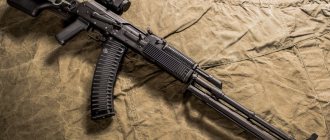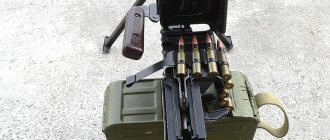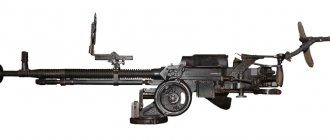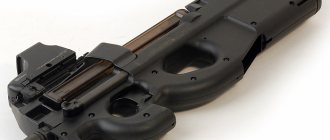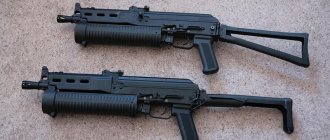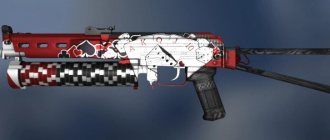The Kalashnikov light machine gun (RPK) is a legendary Soviet weapon developed by the world famous gunsmith Mikhail Timofeevich Kalashnikov in 1961. Over the years of operation, the model took part in several wars and armed conflicts: the Angolan War of Independence, the Vietnam War, the Nicaraguan Civil War, the Mozambican War of Independence, the Ethiopian Civil War and, of course, the Afghan War (1979-1989) - where has established itself as a reliable and effective machine gun.
The history of the creation of the Kalashnikov light machine gun
After the end of the Great Patriotic War, the Soviet command of the armed forces realized that the USSR army desperately needed unified types of automatic weapons. The MG-42 and RPD machine guns were good, but they were not suitable for performing multiple tasks at once - the first was used mainly for the defense of positions, and the second as an infantry weapon. In addition, both machine guns had a huge mass, which significantly reduced the maneuverability of the shooter with the weapon when firing.
In 1953, the GAU put forward certain requirements for the latest models of machine guns: reliability, lightness and versatility. As a cartridge, it was preferable to use the classic 7.62x39 mm automatic ammunition, which has proven itself only from the best side. The development of new weapons was entrusted to Vyatsko-Polyansky. The management decided to organize a competition among the engineering teams so that each group could present their own unitary machine gun within a few years.
After holding a competition and repeatedly refining the winning model, the first sample of the Kalashnikov light machine gun (1961) was presented to the Soviet command, which was almost immediately put into service. Moreover, the number of rifle units ordered was impressive - 200 thousand copies. That is, in each rifle unit, in addition to a sniper with an SKS and a machine gunner with an AKM, there now also had to be a machine gunner with an RPK. However, for Molot such an order did not seem like a big deal, because they significantly simplified the production process of the model.
The AKM (modified Kalashnikov assault rifle) was used as a prototype for the Kalashnikov light machine gun. The trigger mechanism, as well as the ammunition supply system, were subject to minor adjustments. Of course, the machine gun stock was improved - it was almost as strong as the RPD, but weighed significantly less. Under the forend there was an 11-mm bracket, which made it possible to install a bipod on a machine gun or attach it to a machine gun or tripod. That is, the model turned out to be truly universal.
In subsequent years, she was engaged in the production of modified versions of the RPK. Among the most popular models that are used in the army to this day, it is worth highlighting the following three:
- RPKM - a modified version of the standard machine gun, with the ability to install a drum or box magazine;
- RPKS - rapid-fire modification with a modified trigger mechanism and a shortened barrel;
- SSBN is the most modern version of the machine gun, characterized by a high rate of fire and a bracket for installing a night vision device.
It also released several versions of the RPK. In some cases, the model was equipped with a box magazine, in others it had a belt for 200 rounds, in others it was equipped with a drum.
Links[edit]
- David Campbell (2016). Israeli soldier versus Syrian soldier: Golan Heights 1967–73. Fight 18. Illustration by Johnny Shumate. Osprey Publishing. paragraph 78. ISBN 9781472813305. Archived September 30, 2022. Retrieved September 30, 2018.
- Small Arms Review (2005). "Sourcing the Weapons of War: Small Arms Supply to Conflict Zones" (PDF). Small Arms Review 2005: Guns at War. Oxford University Press. item 166. ISBN. 978-0-19-928085-8. Archived from the original on August 30, 2022. Retrieved August 29, 2018.
- Small Arms Review (2007). "Armed Violence in Burundi: Conflict and Post-Conflict Bujumbura" (PDF). Small Arms Review 2007: Guns and the City. Cambridge University Press. p. 204. ISBN 978-0-521-88039-8. Archived from the original on August 27, 2022. Retrieved August 29, 2018.
- ↑
Marko Vorobiev (June 15, 2016). Gun Digest Shooter's Guide to AKs. Krause Publications. pp. 239–. ISBN 978-1-4402-4641-8. - ^ a b c d https://www.tactical-life.com/firearms/rifles/russian-rpk-74-gun/
- Modern small arms RPK Page. Archived July 1, 2007, at the Wayback Machine. Retrieved September 10, 2008
- RPK-74N2 Light Machine Gun (1974). Archived September 26, 2008, on the Wayback Machine. Retrieved September 10, 2008.
- PRODUCT 1PN51 TECHNICAL DESCRIPTION AND OPERATING INSTRUCTIONS [ TECHNICAL DESCRIPTION AND OPERATING INSTRUCTIONS FOR PRODUCT 1PN51
] (in Russian). January 1992. pp. 11, 16. - PRODUCT 1PN58 TECHNICAL DESCRIPTION AND OPERATING INSTRUCTIONS [ TECHNICAL DESCRIPTION AND OPERATING INSTRUCTIONS FOR PRODUCT 1PN58
] (in Russian). February 1991. pp. 5, 13. - "Kalashnikov signs a contract to supply the Ministry of Defense with the latest RPK-16 machine guns". Archived from the original on February 8, 2022. Retrieved February 8, 2022.
- “Army 2016: Kalashnikov presents the RPK-16 LMG | IHS Jane's 360". www.janes.com
. Archived from the original on March 15, 2022. Retrieved March 14, 2017. - https://modernfirearms.net/en/machineguns/russia-machineguns/rpl-20-2/
- https://www.youtube.com/watch?v=EgT2dm-G_X4
- ^ B s d e g h i J k l m p o r QR sec t u V w x y aa a b as adverts ai af aga ah a ^ Jones, Richard D. Jane Small Arms 2009/2010
. Jane Information Group; 35th edition (January 27, 2009). ISBN 978-0-7106-2869-5. - https://i50.photobucket.com/albums/f301/kagemushamu/SmallArms01/SmallArms01-001.jpg
- "Arsenal LMG Page, 7.62 x 39mm". Arsenal. Archived from the original on 2012-02-12. Retrieved April 6, 2010.
- "Arsenal LMG Page, 5.56 x 45mm". Arsenal. Archived from the original on 2012-02-12. Retrieved April 6, 2010.
- "Arsenal LMG Page, 5.45 x 39mm". Arsenal. Archived from the original on 2012-02-12. Retrieved April 6, 2010.
- "Grenade explosion kills three members of Burundi's ruling party". africanews. Reuters. 2017-05-18. Archived from the original on July 5, 2022. Retrieved June 25, 2022.
- "Small Arms Review - Working Papers" (PDF). November 8, 2012 archived (PDF) from the original on July 4, 2010. Retrieved November 16, 2014.
- "Rosyjska broń dla Fidżi" (in Polish). altair.pl. Archived from the original on March 4, 2016. Retrieved February 21, 2016.
- "Archival copy". Archived from the original on November 7, 2022. Retrieved October 30, 2022.CS1 maint: archived copy as title (link)
- Photo agency ITAR-TASS (14.08.2008). "The capital of South Ossetia is in ruins". alamy.com. Archived from the original on August 9, 2022. Retrieved August 9, 2022.
- "Ghana Armed Forces Deny Robbery Charge". exposeGHANA.com
. Archived from the original on November 9, 2014. Retrieved November 16, 2014. - "Archival copy". Archived from the original on October 19, 2013. Retrieved 18 October 2013.CS1 maint: archived copy as title (link)
- “APPLY NOW! Ghana Armed Forces begins recruitment process in 2013". exposeGHANA.com
. Archived from the original on December 17, 2014. Retrieved November 16, 2014. - "Al-Quds RKKS (AKM) Automatic Rifle". awm.gov.au.
_ Australian War Memorial. Archived on December 7, 2018. Retrieved December 7, 2022. - Small Arms Review (2008). “Semi-automatic process? Identifying and Destroying Military Surplus" (PDF). Small Arms Review 2008: Risk and Resilience. Cambridge University Press. p. 99. ISBN 978-0-521-88040-4. Archived from the original on August 30, 2022. Retrieved August 30, 2022.
- ↑
Berman, Eric G. (March 2019). Beyond Blue Helmets: Promoting the Use of Arms and Ammunition in Non-UN Peacekeeping Operations (PDF). Small Arms Review / MPOME. paragraph 43. - Thompson, Leroy (December 2008). "Malaysian Special Forces". Special weapons. Archived from the original on February 19, 2012. Retrieved February 10, 2010.
- "Namibia receives Russian small arms". defenseweb
. June 1, 2016 archived from the original on June 2, 2016. Retrieved June 30 +2016. - LMG Fabrica de Arme Cugir SA page. Archived December 16, 2007, at the Wayback Machine. Retrieved September 10, 2008
- Fabrica de ARME CUGIR SA, LMG Md. 1993 Page. Archived February 10, 2008, at the Wayback Machine. Retrieved September 10, 2008
- Small Arms Review (2006). "Fearmongering: The Lord's Resistance Army and Small Arms" (PDF). 2006 Small Arms Survey: Unfinished Business. Oxford University Press. item 283. ISBN. 978-0-19-929848-8. Archived from the original on August 30, 2022. Retrieved August 29, 2018.
- ↑
Galeotti, Mark (27 June 2022).
Russia's war in Ukraine
. Elite 228. Osprey Publishing. pp. 20, 48, 60. ISBN 9781472833440. - "NVA" Archived from the original on January 30, 2013. Retrieved November 16, 2014.
Performance characteristics of the RPK machine gun
In addition to the fact that the new machine gun became more versatile and ergonomic, it also boasted improved tactical and technical characteristics, despite the fact that the RPD and RPK used the same ammunition. Here are the indicators taken from the weapons passport:
| Characteristic | Parameter |
| Caliber | 7.62 mm |
| Barrel length | 590 mm |
| Barrel type | threaded |
| Ammunition type | 7.62×39 mm |
| Magazine capacity | up to 200 rounds |
| Shot speed | up to 745 m/s |
| Rate of fire | 600 rounds per minute |
| Power | 3500 J |
| Aim | front sight, rear sight, dovetail |
| Energy source | powder gases |
| Weight | 5 kg |
The target firing range deserves special attention. Despite the fact that the rear sight has only 10 gradations for adjustment (100, 200, 300, 400, 500, 600, 700, 800, 900 and 1000 meters), the firing range is up to 3 km. Of course, it is quite difficult to fire effectively under such conditions, but if the weather conditions are suitable and the target is large enough (for example, a light truck), then the RPK will effectively hit it at such a distance. The main thing is to acquire an additional sighting device in the form of optics (11 mm bracket).
Despite the fact that the table with performance characteristics indicates a rate of fire of 600 rounds per minute (10 rounds per second), in real conditions the parameters will be different (from 200 to 300 rounds). The reason for this is simple - a machine gunner usually fires in small bursts of 10-30 rounds in order to use ammunition sparingly and hit targets more accurately. Also, do not forget about overheating of the barrel, which will occur after just a few minutes of continuous fire. And the tape (drum, magazine) will also have to be reloaded.
The mass indicator largely depends on the volume of the magazine with cartridges. The table shows the weight of the weapon itself without the drum or tape attached to it. By equipping the weapon with a box magazine, the weight increases by 0.6 kg, and when a drum is attached, it completely increases to 6.8 kg. Modified versions also differ from the standard RPK in their weight, for example, an RPKS with an equipped drum magazine weighs 7.1 kilograms. Also, do not forget about the weight of the bipod or night vision device attached to the machine gun.
Now about the most interesting thing - the battle accuracy indicator. In shooting range conditions, from a distance of 100 meters to the target, the dispersion indicator is no more than 35 mm - a pretty good indicator for a machine gun. However, when conducting automatic fire, this figure increases many times over. Although most experienced military personnel note that the RPK is one of the most accurate machine guns. Although in real conditions of firing, accuracy is not so important, because the machine gunner is aiming not at one enemy, but several at once (or one large target).
Thanks to the use of the 7.62x39 mm cartridge as the main ammunition for firing, Molot engineers managed to achieve impressive weapon power indicators. Despite the fact that the muzzle velocity is only 745 mm, the muzzle energy fluctuates around 3500 J - this means that the projectile will fly quite far and the shot will be very loud. When firing a machine gun at a concrete surface from a distance of 100 meters, the penetrating power of the bullet was almost 15 centimeters.
Users[edit]
Iraqi soldiers training with Romanian model-1964 (RPK)
Mongolian soldiers with the PKK
Romanian soldier with PM Mk
Fire brigade of the Georgian army with AKM assault rifles and RPK machine guns
- Afghanistan [14]
- Albania: [14] Uses both Soviet and local ASh-78 Type-2
. [15] - Armenia: RPK-47
- Bulgaria: Produced by Arsenal as LMGs
in three different calibers: 7.62x39mm, 5.45x39mm and 5.56x45mm NATO.
There were definitely milled receivers. The folding stock variant is known as LMG-F
. [14] [16] [17] [18] - Burundi [19]
- Cambodia [20]
- Cape Verde [14]
- Cameroon [ link needed
] - Central African Republic [14]
- Chad [14]
- China: Locally produced as Type 56M/Type 56-5; for export only.
- Comoros [14]
- Congo-Brazzaville [14]
- Cuba [14]
- Cyprus: RPK-74
- Djibouti [14]
- Egypt [ link needed
] - Equatorial Guinea [14]
- Ethiopia [14]
- Fiji: [21] RPK-201 variant.
- Georgia: [14] The RPK-74
is still used by the Georgian army and special forces. [22] South Ossetia: RPK-74 variant used. [23]
[27]
is used by
the Grup Gerak Khas
(GGK) of the Malaysian Army. [thirty]
]
]
]
Approximately 1,000–5,000
RPK and RPKS
were purchased from the USSR in the mid-70s for testing.
Previously produced locally as the M64
.
Some of them are stored and their status at the time of adoption is unknown. RPK-74
: Limited use by airborne forces, the last known RPK-74s were retired in 2005 by Tantals.
[ citation needed
]
("light machine gun 1964 model") [32] and a later 5.45 mm version based on the PA md.
86 – Mitralieră md.
1993 (“Light machine gun model 1993”). [33]
]
]
- Lord's Resistance Army [34]
Former users[edit]
- East Germany [ link needed
] - Soviet Union
- Yugoslavia: Produced locally as the Zastava M72.
Structure of the RPK
The design of the Kalashnikov light machine gun is in many ways similar to the AKM prototype - the structure is based on a self-loading mechanism with a gas chamber (part of the powder gases is used to push out the used cartridge case and supply new ammunition). However, here are a few features that distinguish the RPK from the AKM and other machine guns:
- increased initial bullet speed (in RPD it is only 720 m/s) - was achieved by lengthening the barrel channel, as well as a larger number of rifling;
- reinforced receiver with reduced weight - the weapon has become much more convenient to use and has also increased its reliability compared to the MG-42;
- the weight of the barrel was slightly increased, but its service life also increased in comparison with the AKM - a standard barrel bore would not have withstood rapid-fire fire;
- the capacity of a standard disk magazine was increased from 40 rounds to 75, the drum began to hold 100 rounds of ammunition, and the belt held 200 shells;
- a stock made in the same shape as that of the Dyagtyarev light machine gun - the model has proven itself well as a weapon for infantry;
- Unlike the AKM, the rear sight has become adjustable - for more accurate firing at the enemy at different distances.
The unified mount for the under-barrel "body kit" deserves special mention - the bracket allows you to install not only a bipod, but also mount the weapon on a tripod or machine. It was thanks to this feature that the decision was soon made to create a Kalashnikov tank machine gun (PKT), which could also be used by infantrymen.
Review of RPK 16. What was affected by modernization
According to the manufacturer, the RPK 16 will rank with such Western models as the Belgian Minimi and the American M 249. However, the development of Russian gunsmiths is not a purebred machine gun and was built on the basis of the immortal AK 74. Therefore, the new RPK does not have the ability to use a machine gun belt in as ammunition.
Fire can be fired from two sources of ammunition. The first is a standard magazine for a Kalashnikov assault rifle. The second is a drum-type magazine specially designed for the RPK 16. Its capacity is 95 rounds.
But in some ways the Izhevsk gun is even superior to its imported counterparts. According to the developers, the weight of the domestic product is 4.5 kilograms, while competitors weigh on average about 9.
As mentioned above, the machine gun has the ability to install two barrels of different lengths. The short or assault barrel has a length of 410 millimeters, the size of the long one is 550 millimeters. The barrel is replaced without the use of special tools and devices. However, it will not be possible to change barrels in combat conditions - this will take too much time. But this doesn’t make sense, because after replacing the barrel, you need to adjust the sights, which is impossible in combat.
Advantages and disadvantages of the model
A few words about the positive and negative sides of the model, because each weapon has not only pros, but also cons. For ease of reference, we have placed it in a small table:
Advantages and disadvantages
Simplified production technology - the cost of weapons has decreased significantly.
The universal cartridge 7.62 has a huge number of varieties (armor-piercing, tracer, etc.).
Quite light weight for a machine gun (only 1-1.5 kg more than an AK) - the model can be used by infantrymen.
Good penetration ability combined with combat accuracy is second only to modern models.
Limited upgrade - the machine gun does not support the installation of a body kit (except for night vision devices).
A meager number of modifications and design options - the versions differ mainly in the kit.
Low sighting range when using a standard rear sight (for the PKT this figure is 1.5 km).
There is no possibility of installation on a tank (a separate PKT model has been developed for this).
So do the positives outweigh the negatives? Absolutely yes. Just a few decades ago, you would hardly have been able to find any flaws in the PKK at all. However, in comparison with modern analogues entering service with the armies of the Russian Federation and Europe, the Kalashnikov light machine gun no longer seems to be an outstanding rifle unit. Although it is not for nothing that it is in service in many countries of the Middle East and Africa.
Content
- 1 Construction details 1.1 Operating mechanism
- 1.2 Features 1.2.1 Attractions
- 1.2.2 Accessories
- 2.1 RPK 2.1.1 RPKS
- 2.2.1 RPKS-74
- 3.1 RPK-16
- 4.1 Former users
Ammunition for the Kalashnikov light machine gun
The 7.62x39 cartridge is a universal ammunition developed in 1943 for automatic weapons. Most of the machine guns, machine guns and even automatic self-loading ones in the Russian army fire precisely these cartridges. Even some versions of civilian hunting weapons use this particular projectile. The cartridge can only compete with the unitary three-line ammunition of 7.62x39R caliber (model 1930) - used in the Kalashnikov tank machine gun and the Mosin rifle. However, today we will talk about the varieties of 7.62×39 mm:
- With an ordinary bullet with a steel core - the cheapest and most common type of ammunition, designed to defeat enemy personnel hiding behind easily shot through obstacles. Has no distinctive color.
- With a tracer bullet – used for zeroing a weapon or adjusting fire at a distance of up to 800 meters. Unlike the previous version of the ammunition, in this cartridge the bullet has a small glass of paint, which leaves behind a green tracer.
- With an armor-piercing incendiary bullet - the projectile is used to fire at lightly armored enemy vehicles at a distance of up to 300 meters. The core of the cartridge contains a glass with flammable liquid, and the tip is made of tombac. The ammunition is black and red in color.
And although the 7.62x39 mm cartridge does not have as many varieties as the unitary three-line projectile, it has gained great popularity among the military and hunters. The reason is simple - the increased muzzle velocity improves combat sharpness at a distance of up to 1000 meters. However, the projectile is designed specifically for firing from automatic weapons. The cartridge is not very suitable for bolt action rifles.
Disassembling the machine gun
The procedure for disassembling and assembling a Kalashnikov light machine gun should not cause any difficulties for a person who has used an AKM at least once or listened carefully to the teacher in life safety lessons. Here are the instructions to follow to partially disassemble the machine gun:
- We install the machine gun in a vertical position on the bipod.
- Separate the magazine or drum with cartridges.
- We pull back the bolt and check that there is a cartridge in the chamber.
- We perform a control descent.
- We take out the pencil case with accessories.
- Disconnect the cleaning rod.
- Separate the receiver cover (press the button down and pull the body towards you).
- We take out the bolt frame along with the bolt.
- Separate the bolt frame from the bolt.
- Separate the gas pipe with the barrel lining.
It is necessary to assemble the weapon after the partial disassembly procedure according to the same instructions, but in reverse order. Complete disassembly of the machine gun is carried out only if it is necessary to repair a particular system. It consists of the following stages:
- Incomplete disassembly of the machine gun.
- Disassembling the magazine or drum.
- Disassembling the return mechanism.
- Disassembling the trigger mechanism.
- Separating and disassembling the forend.
The weapon is subject to partial disassembly after it had to be used during rain or snow (the lubricating fluid will need to be replaced). Also, do not forget about regular cleaning of lead plaque every 2-3 months. During combat operations, the RPK is disassembled and cleaned after each use.
Design Features
But the manufacturer didn’t play tricks with the automation. The RPK 16 uses the well-proven long-stroke piston design found in AK assault rifles and automatic carbines. The gas exhaust unit is located on top of the barrel. The receiver cover has two pins - front and rear. The rear pin is non-removable and has a spring-loaded design to dampen vibrations. The front pin is removable.
For ease of use, the mode translator has an additional finger molding, which allows you to make switches faster. And most importantly, the handle is now pistol-type, with an internal pencil case. It stores accessories for the care and cleaning of the machine gun.
Another innovation is the aiming system. It consists of an aperture rear sight and a sector sight, which are located on the receiver cover. The rear sight is adjustable and has the ability to make lateral adjustments. The use of this design made it possible to improve aiming and guidance in low light conditions.
The muzzle brake has a design similar to the AK 400. The stock is folding and telescopic. Its range of adjustments allows you to customize the machine gun for a shooter with any biometrics. The stock folds to the left and has a latch.
A mandatory requirement in recent years is the Picatinny rail, located on the receiver in its upper part. Its presence makes the machine gun universal, and it can be equipped with imported attachments. This can be optics, laser and collimator sights.
But even this was not enough for the Kalashnikov engineers. Brackets for installing Picatinny rails are located at the bottom of the forend and on its sides. They are needed for mounting sights, flashlights, night vision devices, as well as a bipod and holder. The use of this simple device increases the attractiveness of the Izhevsk product on the international arms market.
Another useful device that can be equipped with the RPK 16 is the PMS tactical silencer. It significantly reduces the sound level of a shot. This allows the shooter to remain undetectable and also reduces the impact of noise on the hearing aids of the shooter and the soldiers in his environment. In addition, PMS reduces the flash of muzzle gases and serves as a flame arrester.
Sergei Radkevich talks about the new RPK 16
